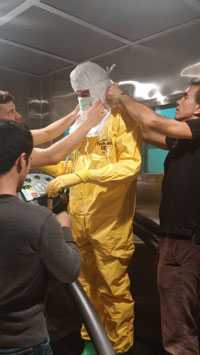Disaster Science Responder Research Program

NIOSH staff members evaluating healthcare worker protection used in the Ebola response under simulated West Africa weather conditions.
NIOSH announces the Disaster Science Responder Research Program (DSRR) to develop an approach that will allow for timely and scalable responder-based research that can be implemented before, during, and after a disaster.
What started out as the Disaster Science Research Initiative (DSRI), is now the Disaster Science Responder Research (DSRR) Program located in NIOSH's Emergency Preparedness and Response Office. The goal of the DSRR is to implement a framework that allows for occupational safety and health research to be started quickly when a disaster or emergency occurs, without interfering with the response itself. The types of research conducted may include: the impact of a novel exposure, unexpected or severe health effects, the effectiveness of a proposed intervention, mental health/resilience issues, and disease outcomes with latency periods. By defining "research" in its broadest sense the DSRR Program includes etiologic, intervention, applied, comparative effectiveness research, worker-based participatory research, meta-analyses, and survey research, with the goal of providing better understanding of the situations and risks responders face. We believe the results of this research will lead to reduced health risks for responders, and to improvements in the effectiveness of emergency responses.
Background
As the federal agency charged by Congress to conduct worker safety and health research, NIOSH has been a leader in the field of disaster science research especially with regard to finding new ways to ensure responder safety and health. In partnership with other Federal and state agencies, as well as private sector entities, NIOSH has made responder safety and health research an important part of its portfolio.
Conducting research on responder safety and health issues during disasters and as part of emergency responses presents unique challenges such as:
- Quickly deciding whether or not a research study is needed;
- Ensuring that the study design does not interfere with the actual response activities; and
- Ensuring that the research provides a benefit for the responders in current or future events.
Questions under consideration for the NIOSH DSRR Program include:
- What are the primary questions needing research considering the possible types of responses and the responders involved?
- Where are the major gaps in our understanding of exposures and other factors influencing responder health?
- What are the major challenges associated with conducting disaster science research to enhance responder safety and health?
- What research is NIOSH uniquely positioned to do in regards to responder safety and health research?
- What role should bio-monitoring play in disaster science responder research and how is it best implemented?
- How does disaster science responder research best fit into existing national response policies and systems?
Stakeholder Workshop
Recognizing the importance of broad input to the DSRR process, NIOSH convened a one-day workshop of invited stakeholders on July 10th, 2014 in Atlanta, GA. The objectives were to: 1) obtain individual input from non-federal experts on what disaster science research is most needed and feasible to address responder safety and health risks and exposures; and 2) discuss the most appropriate role(s) for NIOSH and the extramural community to maximize resource utilization and expertise in the field of disaster science research. Subject matter experts from academia, labor, health departments, and non-governmental organizations joined NIOSH staff to consider the current disaster science research literature and begin discussions about how to ensure the DSRR achieves its objective to support meaningful, practical research to protect the health and safety of emergency response providers and recovery workers.
The workshop brought together a variety of perspectives and viewpoints from the diverse professional experiences of participants. All participants felt there was a need to move DSRR forward and that NIOSH was well-positioned to lead the effort to enhance responder safety and health.
RAND has produced a report on the proceedings of the July 2014 workshop, outlining the rich and varied input on current issues and needs within disaster science research and potential steps forward. NIOSH thanks all the workshop participants for their valuable contributions to DSRR.
NIOSH DSRR Steering Committee
In March 2015, NIOSH created an internal DSRR steering committee charged with the development of a strategic implementation plan to highlight priority areas that need to be addressed over the next two years. The goal of this planning effort is to ensure that rapid deployment, incorporation of research into the response, and funding mechanisms are in place to be able to conduct disaster research in a timely manner. The strategic plan will also aim to identify data collection tools and methods that will be needed to address various research topics.
In addition to this planning role, the DSRR steering committee will also serve to identify and address responder research needs during future disasters. The steering committee will identify additional NIOSH subject matter expertise needed to address the particular disaster research questions involved in the response. This group would prepare a list of research needs that should be addressed immediately as well as a list of less urgent and long term research needs that can be addressed after the responder deployment phase has ended.
Contact Information
For more information on DSRR Program, contact Angela Weber at amw1@cdc.gov.
Related NIOSH Programs and Resources
Emergency Preparedness and Response Program Portfolio
Emergency Responder Health Monitoring and Surveillance (ERHMS)
Guidance Documents for Protecting Emergency Responders
NIOSHTIC-2 Search Results for Emergency Response
Related Publications
NIOSH Disaster Science Research Initiative: Summary of the July 2014 DSRI Workshop
- Page last reviewed: July 1, 2015
- Page last updated: February 8, 2016
- Content source:
- National Institute for Occupational Safety and Health Office of the Director


 ShareCompartir
ShareCompartir